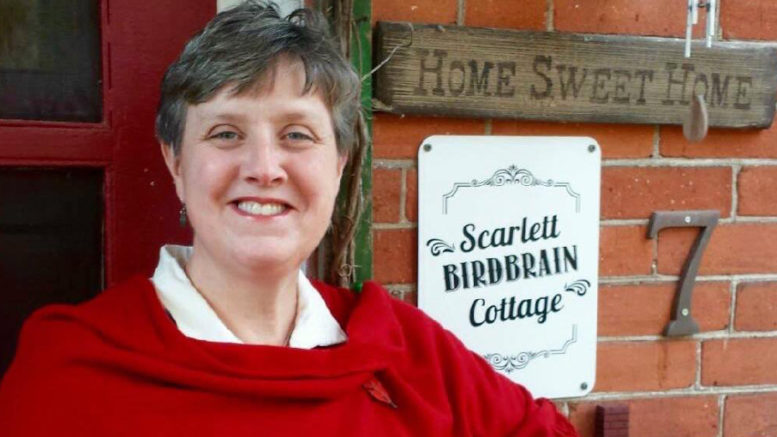Laurie Snider
Notes from the Nest
As I pulled into the gravel parking lot, the amiable, good-natured, official greeter was there to welcome me.
Mud is a four-year-old, border collie-golden retriever cross, mostly black with tan legs, the sweetest face and “ waggiest” tail, who makes it his business to herald all newcomers to his turf with a cordial sniff and wiggle. It’s his way of saying, “Gosh! We’re so happy you came. Can we help you find something?”
I’d arranged to spend the afternoon chatting with Brian Burt to learn about all things greenhouse. We’d agreed beforehand, I’d conduct my interview while trailing him as he went about his duties. Shortly after entering the earthy-scented domed structure I shed my outerwear, as these buildings are called hot houses for a reason. We spent the first 30 minutes pleasantly chatting about he and his wife Ruth’s journey into this floriculture vocation as he seeded an entire pallet of pots with dill. Water, scatter seeds, sprinkle with soil, water, move trays to a different locale, repeat.
Brian met Ruth while they were both attending Queen’s University, he for biology and economics and she also for biology. After they married in 1981, she expressed an interest in market gardening.
Brian said: “We had more guts than brains at the time,” and thus began their lifework operating a thriving greenhouse business.
Initially, they began their craft renting a greenhouse on Fred Brown Road. In 1983 they moved to their present location on Maple Road, which had been Brian’s family’s farm. Brian and Ruth shared that at the outset, they were being “spontaneous with a willingness to try new things and it all snowballed from there.”
Their inaugural plan was to grow flowers but along with becoming parents to three children, they also became farmers with pigs, horses, chickens and turkeys. Flowers for spring and summer formed the bulk of their enterprise but for a period of time they were also growing fall mums and Christmas poinsettias. Brian chuckled telling me: “Our model was to take on too much on principal before realizing it was too many things.”
Slowly they let the excess fall away, deciding to stick with growing flowers for the summer season and vegetables for restaurants and local customers. Fresh herbs, garden greens and beans are available from their greenhouse year-round and they serve and area from Napanee to Ottawa. I can attest that freshly picked Romano beans with a dab of butter and dash of salt and pepper, with a mixed greens salad from Burt’s in March, is a treat beyond compare.
The Burt’s are excellent stewards of the natural world, with a keen awareness of the most environmentally sensitive means of running their nursery. What a fascinating afternoon I spent listening, as he shared their use of an integrated pest management system, to keep invading insects at bay. The idea is to look for solutions to fit specific problems, as opposed to blanketing everything in a chemical haze which ends up wiping out the ‘good guys,’ as well as the ‘bad guys.’
Scouting for — and identifying — pests is an integral part of the job and then deciding on the most limited, least invasive solution for dealing with them.
He showed me a grass-like plant grown specifically for dealing with aphids, “aphid banks,” which are grown early and placed around the greenhouse, in an effort to get a head start on them. On our tour we spotted a frog, ladybug larvae and a pretty, little, moth-like, aphid loving insect called a “lacewing,” all positive signs of natural pest control agents in action. Brian refers to them as “Guardians of the Greenhouse.”
Brian certainly knows his bugs. He described for me some of the unique properties of the tortoise beetle. It’s a magnificent little insect, with a lime green body and translucent wings, with an affinity for morning glories and sweet potato vines. He also recounted a conversation with a customer, concerned about a rather sudden invasion of pests. It turns out they were actually beneficial, aphid-munching soldier beetles. He imparted to me, that when we witness even the smallest interactions, we become sensitive to them. Wise words.
Its not difficult to tell when someone is passionate about their profession. Brian was a wealth of information, having many thought-provoking tales to tell. He explained his philosophy of trying to be a positive influence in an often times perplexing, muddled up world. He believes small, grassroots solutions lead to meaningful progress. His hope is that by encouraging people to garden and get outside in the natural world, it will help them to notice even the tiniest things, appreciate them and then care about saving them. I couldn’t agree more and look forward to digging in soon!

